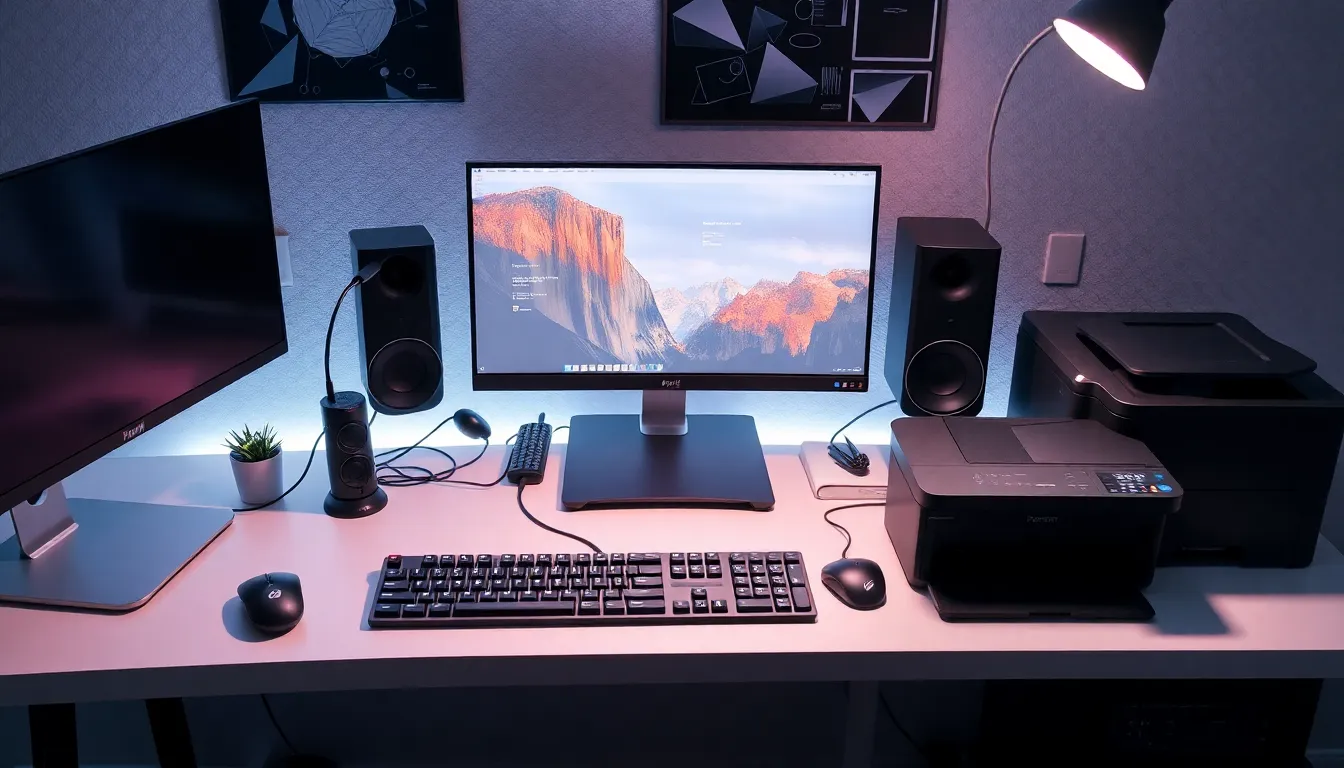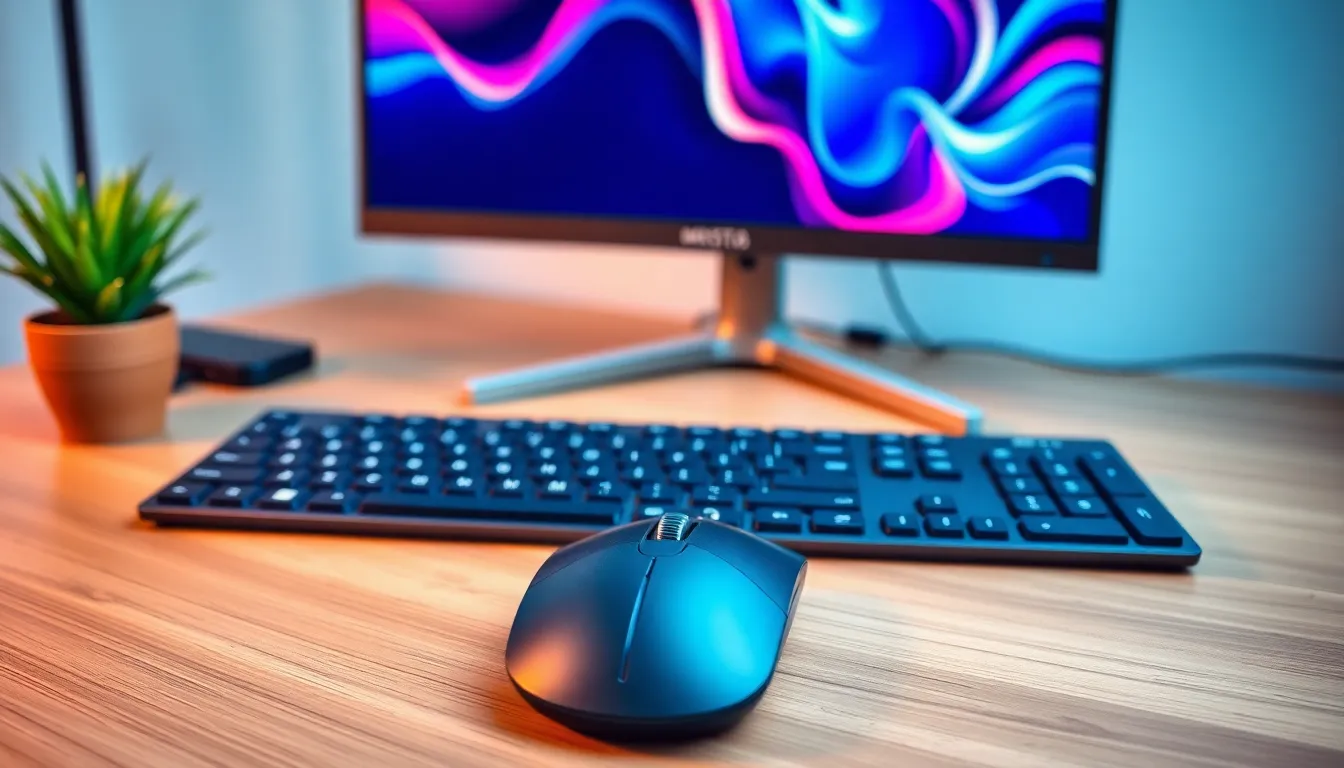Table of Contents
ToggleIn the world of computers, the magic doesn’t just happen inside the box. Enter the unsung heroes: computer peripherals. These nifty gadgets transform a mundane machine into a powerhouse of productivity and creativity. From keyboards that make typing feel like a dance to mice that glide smoother than butter on a hot pan, peripherals are the secret sauce that spices up the computing experience.
Think about it—what’s a computer without a monitor that brings visuals to life or a printer that can turn your digital dreams into tangible reality? It’s like a pizza without toppings—sure, it’s still food, but where’s the fun? Whether you’re a gamer, a designer, or just someone who wants to scroll through cat videos in style, understanding the world of computer peripherals can elevate your setup from basic to brilliant. So, let’s dive into this exciting realm and discover how these gadgets can revolutionize the way we work and play.
Overview of Computer Peripherals
Computer peripherals serve as critical components that enhance the user experience. These devices connect externally to the computer and include various tools such as keyboards, mice, monitors, and printers. Each peripheral fulfills specific roles, contributing significantly to productivity and creativity.
Keyboards allow users to input data efficiently, while mice facilitate navigation across screens, providing precise control. Monitors display visual content, making interactions engaging and allowing users to work on complex tasks with ease. Printers play a vital role in producing tangible copies of documents, enabling sharing and record-keeping.
Audio peripherals like speakers and microphones enhance multimedia experiences. Speakers output sound, creating an immersive atmosphere for games, music, and videos. Meanwhile, microphones capture audio input, essential for communication and content creation.
Storage devices, including external hard drives and USB flash drives, expand data capacity beyond internal memory. Users can store large files and backup critical information easily, promoting organization and security.
For gamers, specialized controllers elevate interactive experiences, providing responsive feedback and immersive gameplay. Graphics tablets serve artists and designers, allowing detailed input for creative projects.
Ultimately, computer peripherals bridge the gap between users and technology. Their diverse functionalities make them indispensable tools in both personal and professional settings. With the right selection of peripherals, individuals can transform their computing experiences into productive and enjoyable activities.
Types of Computer Peripherals

Various types of computer peripherals enhance functionality and user experience. These devices fall into distinct categories, such as input devices, output devices, and storage devices.
Input Devices
Input devices allow users to communicate with a computer. Keyboards enable text entry, while mice facilitate precise navigation and interaction. Touchpads and game controllers provide alternative user experiences. Scanners capture images of documents and photographs, converting them into digital formats. Graphics tablets offer artists a way to create digital art with precision. Each input device plays a unique role in catering to different user needs.
Output Devices
Output devices present data processed by a computer in a usable format. Monitors display visual content, showcasing everything from text to high-resolution images. Printers produce hard copies of documents and photos, making digital information tangible. Projectors allow for larger displays in presentations or group settings. Speakers and headphones enable immersive audio experiences, enhancing engagement with multimedia. All these devices serve to communicate information effectively.
Storage Devices
Storage devices maintain and protect data for future access. Hard disk drives and solid-state drives offer primary storage solutions, each with distinct performance characteristics. USB flash drives provide portable storage, allowing users to transfer files easily. External hard drives serve as backup options for important data. Cloud storage solutions enable users to access files from any device with internet connectivity. All storage devices contribute to better data organization and accessibility.
Importance of Computer Peripherals
Computer peripherals serve as essential tools that enhance computing experiences. They transform basic setups into powerful workstations, improving functionality and convenience. Devices like keyboards and mice foster efficient navigation and data input, making tasks simpler and faster.
Monitors create immersive visual environments, while printers produce valuable hard copies of digital documents. Audio peripherals such as speakers and microphones enrich multimedia interactions, adding depth to presentations and entertainment. Specialized peripherals cater to specific needs; for instance, gamers benefit from controllers and graphics tablets that enhance interactivity.
Categories of peripherals, including input, output, and storage devices, showcase their diverse roles. Input devices, like touchpads and scanners, allow users to communicate with computers seamlessly. Output devices present processed information in engaging formats, further enriching user experiences. Storage devices maintain data integrity and accessibility, ensuring vital information remains organized and protected.
Individuals rely on these peripherals to navigate their digital worlds effectively. They bridge the gap between users and technology, enabling productivity and creativity across various fields. In both personal and professional settings, the impact of computer peripherals resonates, underscoring their value and necessity in modern computing.
Choosing the Right Computer Peripherals
Selecting appropriate computer peripherals enhances overall functionality and user experience. Several critical aspects influence this decision.
Factors to Consider
First, compatibility with the operating system is essential. Users should confirm that peripherals will work seamlessly with their computers. Ergonomics also matter; choosing comfortable keyboards and mice prevents strain during prolonged use. Assessing connection types, such as USB or Bluetooth, can streamline setup. Performance specifications, including response times for gaming mice or resolution for monitors, should align with individual needs. Lastly, budget constraints play a significant role in decision-making, guiding choices towards the best value without compromising quality.
Top Brands and Products
Popular brands consistently deliver reliable peripherals. Logitech offers high-performance mice and keyboards renowned for durability. Razer specializes in gaming equipment, featuring customizable RGB lighting and precision. Dell and HP provide quality monitors, known for their clarity and color accuracy. For audio, Bose and Audio-Technica produce speakers and microphones with superior sound quality. When shopping for storage devices, Western Digital and Samsung are trusted names, offering reliable performance across various capacities. Evaluating these brands can help identify products that meet personal and professional requirements effectively.
Trends in Computer Peripherals
Current trends in computer peripherals reflect technological advancements and evolving user needs. Wireless technology has seen significant growth, offering convenience and flexibility. Bluetooth keyboards and mice provide users with a clutter-free workspace, allowing for greater mobility.
Ergonomic design continues to gain traction. Innovative shapes and materials reduce strain during prolonged use, promoting better health. Adjustable monitors enhance comfort levels, catering to various viewing preferences.
Gaming peripherals have entered a new phase of sophistication. High-refresh-rate monitors and mechanical keyboards enhance the gaming experience, delivering precise response times. Specialized gaming mice with customizable buttons support complex gaming strategies.
Sustainability is another emerging trend. More manufacturers focus on eco-friendly materials and energy-efficient designs. Brands like Logitech have introduced products with recyclable components, appealing to environmentally-conscious consumers.
Smart technology integration increases compatibility between peripherals and devices. Smart speakers and voice-activated assistants create seamless interactions. Users can manage their environments using a single command, reinforcing efficiency.
Additionally, augmented reality (AR) and virtual reality (VR) peripherals are on the rise. These technologies provide immersive experiences in training, gaming, and remote collaboration. Accessories such as VR hand controllers and sensor-equipped gloves enhance user interaction in digital spaces.
Finally, customization options appeal to diverse user preferences. Gamers and professionals often select peripherals that match personal aesthetics or functionality. Customizable RGB lighting and programmable keys allow for personalized computing experiences.
Computer peripherals are vital components that significantly enhance the overall computing experience. They not only improve functionality but also cater to the diverse needs of users, whether for work or leisure. The evolution of these devices reflects ongoing technological advancements and changing user preferences.
As individuals continue to explore the vast possibilities of computing, investing in the right peripherals can lead to increased productivity and enjoyment. With options ranging from ergonomic designs to advanced gaming tools, there’s something for everyone. Embracing these essential devices allows users to fully unlock their potential in an increasingly digital world.



